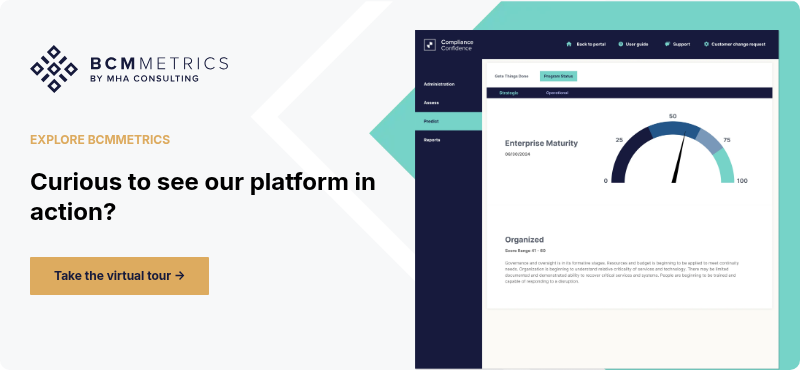Prepare For the Worst with the Best in the Business
Experience capable, consistent, and easy-to-use business continuity management software.
We’re helping you streamline your BIA, cutting it down from 8 to 4 hours or less for each business unit and maximizing your BIA interview.
We veteran BCM professionals will need to learn some new tricks to work effectively with millennial generation members. Specifically, I gave the example of the traditional business impact analysis (BIA) meeting as something that probably won’t work very well with colleagues and clients who are used to speedy and informal ways of doing things.
After finishing that post, it occurred to me that I had left readers hanging in terms of how exactly they might go about making their BIA meetings more efficient. In today’s article, I’m going to make that up to you by giving you my 5 Tips for Making the Most of the BIA Interview. These tips aren’t only relevant when working with millennials. These days, pressure for BIA professionals to be more efficient comes from across their organizations.
In days gone by, the BIA process would take anywhere from 6 to 8 hours for each business unit, from the pre-work and interview through the follow-up phase to the final approval of results. In today’s world, the entire BIA process better take from 3.5 to 4 hours or less for each business unit, from pre-work to final approval.
Needless to say, even as you are speeding things up, you’re still expected to cover all the important bases, doing as good or better a job as you did before. Nobody said it was going to be easy! But hopefully the tips below will make it easier for you.
And in the spirit of the subject, I’m going to try to keep things short and sweet.
Tip No. 1: Stay Focused on the BIA’s Purpose
Keep your BIA to its primary purpose and objectives. The BIA is designed to identify the criticality of each business process and its associated requirements (systems, dependencies, etc.). Its purpose is not to design the recovery strategy or build the entire recovery plan. Less is more.
Tip No. 2: Leverage Pre-Work for Faster Interviews
Develop pre-work to capture the critical path information for each business unit so you can enter it into your BIA tool ahead of your interview with that unit. This will save time during the interview. Make your pre-work as concise and to the point as possible. Do not ask questions in your BIA that don’t pertain to its essential purpose. Pre-work should take no more than 30 minutes to complete.
Tip No. 3: Maximize the BIA interview
Create a plan for conducting the BIA interview in 2.5 hours or less. Budget your time something like this:
| Topic | Time Allowed |
| Introductions, study questions, etc. | 5 minutes |
| Department overview Days and hours of operations Potential changes over the next 12 months |
5 minutes |
| Individual business process overviews Impacts: Assess dollar and non-dollar impacts of not performing the process over time Systems, applications, other specialized equipment Dependencies: Internal and external, manual workarounds and vital records |
20 – 25 minutes per process |
Tip No. 4: Share the BIA Results Promptly and Clearly
Send the results to the interviewees immediately so they can review and approve them. Discuss any questions or concerns with them and make adjustments as necessary. It should take less than 15 minutes for the participants to review the results.
Tip No. 5: Put Your BIA Data to Work
Use the BIA data to plan recovery strategies and to help complete and/or update the business recovery plan. Develop a process to get the data exported to the plan.
These tips should help you streamline your process while still getting all the information you need to build your recovery plan. That’s an outcome that should please everyone, whether they’re a baby boomer, a millennial, or anything in between.
How the BIA On-Demand Tool Supports Business Impact Analysis (BIA) Interviews
You work hard to make your business a success—shouldn’t that include protecting your most critical assets? A BIA is the first step to ensuring that your business will continue to thrive in the event of disruptive external factors beyond your control.
We’d like to help you take this first step. BIA On-Demand makes it easy for you to pinpoint the most critical units of your business. Running in a secure portal, the tool walks you through a full evaluation of your business processes, including dollar and non-dollar impact as well as recovery time objectives. In the end, it automatically calculates the level of criticality of each unit you’ve chosen to evaluate and produce a detailed report of the results.
Take a virtual tour of how BIA On-Demand works or to get in touch with questions. If you’re struggling with a BIA currently or want guidance through the process, we’re here to help.

Michael Herrera
Michael Herrera is the Chief Executive Officer (CEO) of MHA. In his role, Michael provides global leadership to the entire set of industry practices and horizontal capabilities within MHA. Under his leadership, MHA has become a leading provider of Business Continuity and Disaster Recovery services to organizations on a global level. He is also the founder of BCMMETRICS, a leading cloud based tool designed to assess business continuity compliance and residual risk. Michael is a well-known and sought after speaker on Business Continuity issues at local and national contingency planner chapter meetings and conferences. Prior to founding MHA, he was a Regional VP for Bank of America, where he was responsible for Business Continuity across the southwest region.
.png)
.png)




